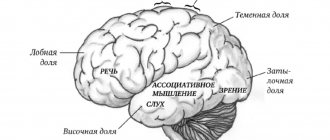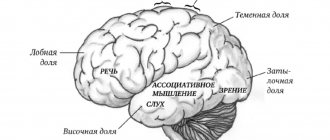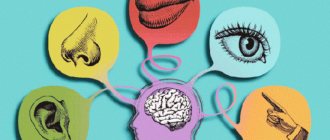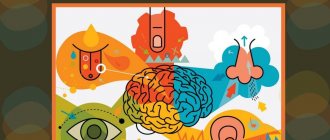The article describes in accessible language the basic laws and stages of the perception process that everyone needs to know.
We perceive the world through our sensations. When any objects impact our sense organs, temporary nerve connections are formed in the cerebral cortex, conditionally reflex processes; stimuli are analyzed and synthesized. Perception is a mental process of searching for signs on the basis of which an image can be formed and comprehended. At the same time, our sensations are selected, systematized and interpreted in some way.
As a result of perception, we receive an image. One of the analyzers plays a leading role in this process and determines important features, and on their basis – the properties of the perceived object. Based on the analyzers that take part in the process of perception, visual, tactile, auditory, muscular and other perceptions are distinguished.
In humans, as a rule, the leading sense organ is vision, and therefore the properties of perception were studied primarily on this basis. Investigating what and how influences the formation of visual images, representatives of Gestalt psychology (early 19th century, Germany) derived the laws of visual perception (according to M. Wertheimer):
- If the figures are similar, that is, if they are united by some common characteristics (for example, shape), then, based on the similarity, our perception combines them into groups.
- If the figures are located close to each other, our perception tries to unite them.
- If the figures have any similar changes, our perception also tries to unite and group them.
- If the figures are in a confined space, they are perceived better and easier.
- If there are several figures, they try to group them in such a way as to unite all without exception, so that not a single free-standing figure remains.
Science cannot yet explain the mechanism of the brain that forces us to adhere to these laws of visual perception. Therefore, the identified patterns are so far simply perceived as phenomenological.
The following observations should also be included in the laws of perception:
- Whatever we perceive, the brain structures incoming signals, perceiving them as figure and ground. What is clear to us, clearly perceived, is the figure, and its surroundings are the background. When switching attention, the background and figure can change places (as in the picture of the Rubin vase). This selection of a “figure” from the “background” can concern not only vision, but also, for example, hearing (we “snatch” words of interest from a stream of noise: for example, our name), smell, etc.
- No matter what we observe, the brain tries to “complete” the missing fragments into a whole figure, to show the integrity of the image. This applies not only to the image, melody, elements of phrases or words, this is also the law of human perception by man: we infer what we do not know based on what we see and hear.
- But perception is influenced by our expectations, guesses, assumptions: what is presented to us, we perceive based on its environment, likening it to something similar. For example, as a manifestation of this law, when perceiving a person as a person, we attribute to people the traits that we expect to see in them.
In psychology, the following laws of perception are also distinguished:
- Perception is associated with the work of muscles, with movements containing information about the objects that are perceived.
- Already formed images are relatively stable, especially if associated with thinking.
- A necessary condition for correct perception is the constant supply of new information that clarifies and corrects the emerging image.
- In the process of development of perception, the formation of images depends on the experience gained, sensations, and when perception has already been formed, the nature of the images is partially determined by the internal processes occurring in the body.
Stages of the perception process
If perception is considered as a mental process in which there is a search for signs that form an image and contribute to making decisions on this basis, the following stages can be distinguished in it:
- Stimuli are identified from the flow of information, and on their basis a decision is made about their relationship to any one specific object.
- The same or similar complex of sensations are extracted from the memory archive. They are compared with the current characteristics, on the basis of which a judgment is formed about what kind of object is in front of us.
- The perceived object belongs to a certain category, then the search continues for signs that help determine whether the decision was made correctly or incorrectly.
- A final conclusion is made about what kind of object is in front of us, and it is endowed with properties inherent in objects of the same class as it.
Features of human development
Some laws of perception of the surrounding world have been established through simple experiments and observations. Thus, researchers compared passive children and active children under certain conditions. One of these experiments was observing people who found themselves in an inverted space.
The laws of perception apply to everyone without exception. Proof of this is the experience with glasses that display the world around us upside down. A person wearing such optics will adapt to changing conditions.
The brain begins to identify objects and make analogies taken from accumulated experience. Literally a month later the person feels comfortable in the new conditions and lives a normal life. But as soon as he takes off his optics, he again gets lost in space for some time.
It’s easy to notice the laws of perception when you drive off the highway into city streets after a long trip at high speed. Everything seems so slow that it feels like you're walking. To restore the feeling of speed, it is enough to stop for just an hour or two. The example with optics requires more time to adapt to changing conditions.
Color perception
Today, psychologists distinguish two main levels: the sensation of color and its perception. But there is another level - “sense of color” - and it is important and specific in artistic creativity. If the sensation of color is determined by the physiology of vision and is considered the simplest mental act, then perception is a more complex process, associated with certain psychological laws. But the sense of color is more related to the aesthetic and emotional spheres.
There are some laws of human perception of color. They are caused by the peculiarities of our visual organ’s perception of color under different conditions. When perceiving color, lighting and adaptation, brightness and induction play a role. The subtleties of the nature of color, combinations and characteristics of colors, the laws of human perception of color are the subject of the study of coloristics. But we will dwell on some points in more detail.
Interestingly, colors located next to each other influence each other. Moreover, colors are always perceived depending on the environment. Thus, squares of the same size but different colors are perceived differently: white on a black background seems larger than black on a white background. An orange square in a red frame becomes yellow, and on a yellow background it turns red. A gray square on an orange background turns blue, and on a blue one it takes on an orange tint.
Color has always had a strong influence on a person, affecting his psychological state and physiological processes. We are influenced by the saturation or pallor of a color, its shades, its combination with other colors. Bright colors have the power to attract attention much faster than pale ones. Light colors are more pleasing to the eye than dark ones. Knowing the features and laws of human perception of color, you can use this knowledge in everyday life, for advertising purposes, you can evoke certain emotions, create a certain mood, form associations and images.
Psychologists, based on a person’s color preferences, can analyze his psychophysiological state (Luscher test).
Each color has its own effect on the human psyche and evokes different associations. Let's consider some patterns - general, important both in design and in life, laws of color perception, identified by psychologists.
Red is the color of passion, energy, pressure, intensity, fire, strength. It excites the nervous system, improves mood, and stimulates brain function. With prolonged exposure it can irritate, even increase blood pressure and increase stress.
Orange is a sunny, joyful color, cheerful and dynamic, it is associated with friendship, openness, stimulates, invigorates, sharpens perception, and promotes problem solving. It gives a feeling of happiness and well-being, speeds up the heart rate without increasing blood pressure. This color is cheerfulness and improvisation. But you need to take a break from it: it can tire you. It is the color of energy, balance, enthusiasm. But sometimes it can be perceived as the color of ignorance and lies.
Yellow is the color of joy, fun, it attracts attention and improves mental activity. Yellow color helps solve problems and problems, stimulates the brain, promotes learning, promotes clarity and accuracy of thought. Those who prefer this color are distinguished by their desire for independence and expansion of their horizons of perception. But it can cause laziness and even envy. This is the color of summer, gold, sunshine, idealism, joy, but also risk, deception, greed, illness.
Green is the color of calm, freshness, relaxes and calms the nervous system. This is the color of balance. The color green is believed to soothe pain and reduce fatigue. This is a "quiet" color. As a rule, it is liked by balanced and calm people who are prone to self-affirmation. This is the color of spring, nature, vigor, youth, restoration, as well as inexperience, envy, failure. Some people associate it with money (dollars), even with greed.
Blue and dark blue - these colors reflect peace, tranquility, trust, conservatism, and create a “cool” background. It is believed that these colors help relieve neurological pain, reduce anxiety, and lower blood pressure. But with prolonged exposure, they cause fatigue and fatigue. Blue is considered the color of trust, self-confidence, calmness, reliability, but can be perceived as cold.
Purple is the color of mystery, it is mystical, it has some magic. It is the color of knowledge and wealth, but can cause sadness. This color is preferred by people with unstable character; it is called “the color of female loneliness.” Purple color affects the heart, blood vessels, and psyche.
Black is the color of mystery and depth, power and dignity. Well, at the same time, it can provoke fear and anxiety.
White is the color of light and perfection, purity, simplicity, but at the same time it is the color of cold, and sometimes emptiness.
Briefly, we can characterize the primary colors as follows: stimulating colors include red, orange and yellow, depressing colors include purple, dark gray background and black background, and calming colors include green and blue colors.
Color researcher, Swiss artist I. Itten, created a model of a 12-frequency circle, and on its basis described seven types of color contrasts, illustrating how with the help of other contrasting colors you can enhance or weaken the impression of a particular color.
Based on sociological research, colors can be arranged from most to least preferred, thus: blue - purple - white - pink - purple - red - green - yellow - orange - brown - black.
A person’s perception develops constantly, under the influence of the conditions of his life.
Attention, memory, thinking and perception can be developed daily, in a fun way, using online brain and memory training exercises.
We wish you success in self-development!
Why is this happening?
Correct perception of space directly depends on the movements of parts of the human body. The important role is played not by the movement itself from point A to B, but by the process in which muscle work is involved. Adaptation to changing conditions occurs only through motor skills and the performance of repeated manipulations.
Children learn about the world around them through constant play. Adults are more adapted to learning, learning something new while moving. This is the peculiarity of perception, which is proven by the simplest experience:
- One of the adults was given optics that reversed the image of the surrounding space, and forced him to immediately move and try to perform daily functions. At first he was confused, but he quickly adjusted himself and began to perceive the world as usual.
- Another adult was forced to be passive and sit in a chair without making any movements at all. He was also given similar optics. Even after a long time, he was still unable to adapt to the changed conditions.
Correct memory recording
Information about surrounding objects enters the central nervous system. For the correct formation of parameters and properties of objects, a constant and maximum influx of new information is required. This is possible only during the movement of the body or at least its parts.
Suitable conditions are created by exercises that are performed according to proven patterns. This is how we learn to walk and swim. As a result of repeated actions, new information is recorded and corrected when a discrepancy is detected.
An example of training is an experiment where any person is placed in a pool of water for a long time. The temperature of the new space is comfortable, but the test subject cannot feel it thanks to special equipment. The pads completely cover the skin and eliminate the possibility of touch. So a person cannot hear anything, his eyes are closed.
After some time, it is removed from the water and its condition is checked. The result of the experiment is:
- violation of orientation in space;
- the ability to perceive the passage of real time disappears;
- the ability to normally capture the parameters of surrounding objects decreases;
- the ability to correctly perceive tastes, sounds, colors is impaired;
- Some people experienced hallucinations as a result of the disorder.
The results of the experiment allowed us to conclude: a person needs a constant supply of information about the surrounding space to correctly perceive it. Once you move to new conditions for a short time, the so-called destruction of existing superstructures occurs. Often in common people they are called habits.
Habits change thanks to a new flow of information about the world around us. The more powerful the flow, the faster a person relearns. In this case, the muscles become something like conductors with little resistance to information. They seem to strengthen the channels for its movement straight to the central nervous system.
Memory
The perception of objects is accompanied by the recording of stable images in memory, which persist for a long time under suddenly changed conditions in space. So, in the above example, when a person puts on glasses that turn the picture upside down, a disturbance in perception occurs. The real situation does not correspond to what is already familiar and it is necessary to rewrite the existing database.
The second law of perception can be attributed to memory: images of the surrounding reality are retained for a long time, thinking reinforces them. Experience with glasses is proof: if an ordinary person puts them on, he can get lost. The same thing happens if you take them off after wearing them for a long time: the memory has already overwritten the familiar images and again there is discomfort and disorientation.
As a result, we can draw conclusions: perception and understanding directly depend on a person’s accumulated experience in the process of learning about the world around him. The memory of images, even after rewriting in a new environment, distorts the real parameters of objects. The brain is always looking for a match between the appearance of a new object and the appearance of previously encountered images.
When the situation is familiar, thinking regarding this issue is partially switched off, and the person already intuitively perceives the surrounding reality. This explains the disappearance of discomfort in new conditions. The speed of adaptation is different for everyone; this period is significantly reduced due to “muscle memory”.
The younger generation adapts to changing conditions faster because its representatives are constantly on the move. It is worth noting: if older people exercised daily or at least avoided static states, they would easily rewrite their memory area. This refers to the one that is responsible for the perception of the surrounding space.
It’s enough just to walk around the room, and the process of getting used to the glasses will be much more effective than for those who sit in a chair and look at the world only by turning their heads. The speed of adaptation increases when the organs of hearing and touch are involved. When feeling surrounding objects, objects are recognized faster.
Famous works of philosophers
The main assumption of scientists about the acquisition of abilities to understand the world was nativist, or natural. It looked at the question in the following way: all information is embedded in a person from birth through genes. The areas of the mind responsible for this are formed according to laws that are still unclear to science. The works of the English psychologist and philosopher J. Locke have many thoughts on this topic.
His works and those of many of his followers compare possible options for acquiring abilities through work and experience. Refutations of the theory about the accumulation of memory throughout life are also provided. Thus, I.M. Sechenov, a domestic psychologist, considered the role of muscle memory in human life.
D. Bohm considered the theory of acquiring abilities through human movement. His works contained experiments comparing the adaptation of an active and passive individual. But their works did not contain any scientific evidence of the process of information accumulation. The hypotheses remain unconfirmed and raise doubts among many communities searching for answers to this question.
At the moment, all philosophers and psychologists agree on only one thing: a person absorbs information about the world around him through the senses, but part of it comes through invisible ways: the mind or is formed at birth. The surrounding world influences consciousness and distorts the idea of surrounding objects. This is confirmed by the simple experiment below.
Often a person cannot immediately determine the obvious essence of a visible object. The subject is shown a blurry drawing; it is unclear to him what is depicted. But when researchers name objects and show their outlines, a full picture of individual objects immediately emerges in the subject’s brain.
The person gave meaning to what he saw with the help of his own thinking. Trial and error play an important role in this process. Each time refuting its conclusions, the brain corrects the memory and the next time identifies objects accurately.
Internal conflicts
The process of perception is complex in terms of event classification. It can be described by a set of accidents in the life of each individual. The area of memory responsible for storing the accumulated base of comparison with the outside world is affected by all senses: hearing, vision, touch, smell, taste.
Under certain conditions, a person’s internal thinking comes into conflict with the innate reflex - to experience the world as it is. So, when you see a flying person, the first negative reaction arises: “this can’t be.” But if he himself flies after a while, then inner peace will come - the adaptation of memory to changing conditions has been successful.
If it is impossible to adapt, when a person has internal contradictions, difficulties are observed in assessing the surrounding space. Disorientation persists, the person cannot lead a normal life in the new conditions. In this case, he will need psychological help and training. All information is contained in the internal structures of the brain. This is proven by a study of the feelings of people who have experienced limb amputation.
For a long time it seems to a person that he can move it and feels it. For many, this feeling lasts for the rest of their lives. Phantom pains occur periodically, preventing the patient from adapting to the new reality.
Intuitively, a person tries to grab a falling object with his missing hand or grab a handle or handrail with it. Memory is firmly fixed in the depths of the nervous system, the brain. Phantoms are developed over the course of life. If a limb is missing from birth, this effect is not observed.
Age
The laws of perception in psychology are determined by the process of human development. An established worldview is more difficult to disrupt with age. Up to 9 years of age, internal memory accumulates. Upon completion of this time threshold, a complete base of perception of the surrounding space is accumulated.
It is for this period of life that a person is adapted to life. The basis of perception has already been prepared. From this age, phantoms are observed after limb amputation.
No one has yet provided clear evidence indicating a psychological component in the work of the senses. The examples given are only the results of the research; it is not possible to explain the deep meaning of the perception of the surrounding world from a scientific point of view. Scientists cannot give a definitive answer on how a person can acquire the following abilities through the senses:
- thinking, the ability to make logical conclusions;
- intuitive abilities;
- gestal structures of perception.
It is impossible to answer the question of how a person acquires these abilities through the senses. This is mainly studied by philosophers. The scientific point of view does not explain the mechanisms of transmission of hidden information.
From experiments it is clear that for the correct perception of the world it is not enough to cognize the world with the senses known to us. Some information about the world around us must come through other channels that are still unknown to science.
Conclusions from experience
Correct perception of space directly depends on the physical activity of the individual. There is something called muscle memory, although its involvement cannot be proven by tangible facts. When moving, the organs of hearing, vision, and touch work more actively.
This is how the internal processes of forming the abilities to perceive and understand beauty are more intense. Movement is necessary for proper human development. According to most scientists, adequate images are formed only under such conditions.
Movements can also be internal; it is important that they be muscular. Even visual perception occurs due to the chaotic movement of the pupil of the eye. When its position is static, the object becomes blurred. This may be due to the adaptation of cones and rods.
It has been proven that such perception is unnatural; it occurs when inhibition of all body systems is observed. The image of the object seems to disappear from the person’s field of vision.









